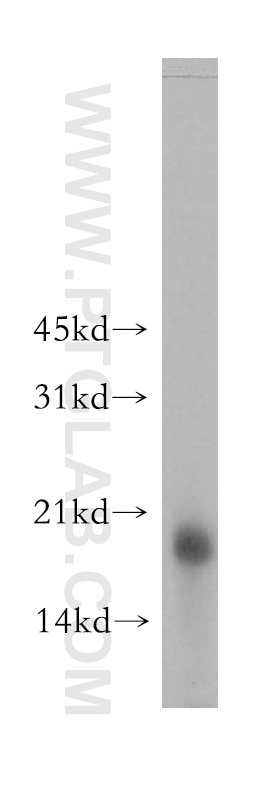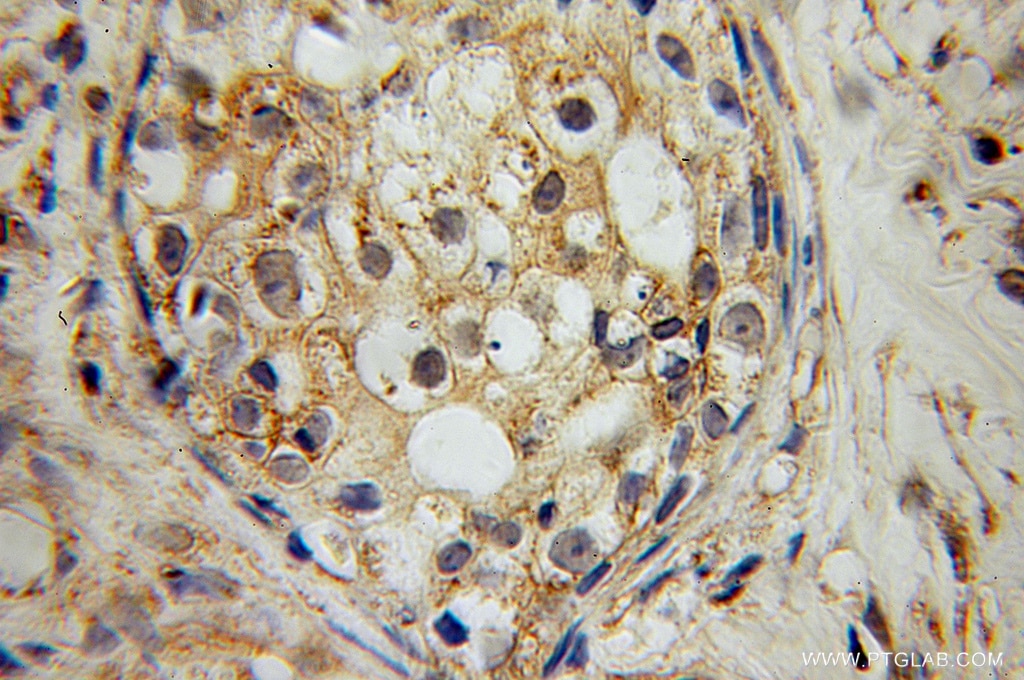Anticorps Polyclonal de lapin anti-RAMP2
RAMP2 Polyclonal Antibody for WB, IHC, ELISA
Hôte / Isotype
Lapin / IgG
Réactivité testée
Humain, rat, souris et plus (1)
Applications
WB, IHC, ELISA
Conjugaison
Non conjugué
N° de cat : 13223-2-AP
Synonymes
Galerie de données de validation
Applications testées
| Résultats positifs en WB | tissu cérébral de souris |
| Résultats positifs en IHC | tissu de cancer du sein humain il est suggéré de démasquer l'antigène avec un tampon de TE buffer pH 9.0; (*) À défaut, 'le démasquage de l'antigène peut être 'effectué avec un tampon citrate pH 6,0. |
Dilution recommandée
| Application | Dilution |
|---|---|
| Western Blot (WB) | WB : 1:500-1:1000 |
| Immunohistochimie (IHC) | IHC : 1:20-1:200 |
| It is recommended that this reagent should be titrated in each testing system to obtain optimal results. | |
| Sample-dependent, check data in validation data gallery | |
Applications publiées
| WB | See 2 publications below |
| IHC | See 2 publications below |
Informations sur le produit
13223-2-AP cible RAMP2 dans les applications de WB, IHC, ELISA et montre une réactivité avec des échantillons Humain, rat, souris
| Réactivité | Humain, rat, souris |
| Réactivité citée | bovin, Humain, souris |
| Hôte / Isotype | Lapin / IgG |
| Clonalité | Polyclonal |
| Type | Anticorps |
| Immunogène | RAMP2 Protéine recombinante Ag4028 |
| Nom complet | receptor (G protein-coupled) activity modifying protein 2 |
| Masse moléculaire calculée | 175 aa, 20 kDa |
| Poids moléculaire observé | 20 kDa |
| Numéro d’acquisition GenBank | BC027975 |
| Symbole du gène | RAMP2 |
| Identification du gène (NCBI) | 10266 |
| Conjugaison | Non conjugué |
| Forme | Liquide |
| Méthode de purification | Purification par affinité contre l'antigène |
| Tampon de stockage | PBS with 0.02% sodium azide and 50% glycerol |
| Conditions de stockage | Stocker à -20°C. Stable pendant un an après l'expédition. L'aliquotage n'est pas nécessaire pour le stockage à -20oC Les 20ul contiennent 0,1% de BSA. |
Informations générales
RAMP2 (receptor-activity-modifying protein) is a member of the RAMP family of single-transmembrane-domain proteins which consist of an N-terminal extracellular domain, a transmembrane region and a short intracellular C-terminal tail. RAMPs are required to transport calcitonin-receptor-like receptor (CRLR) to the plasma membrane. CRLR, a G protein-coupled receptor, can function as either a calcitonin gene-related peptide (CGRP) receptor or an adrenomedullin receptor, depending on which members of the RAMP family are expressed. RAMP1 transports the CRLR to the plasma membrane and then remains associated with it to function as a terminally glycosylated CGRP receptor, while RAMP2 and RAMP3 transfer the CRLR to the cell surface to generate receptors that are preferentially selective for adrenomedullin. (PMID: 9620797; 16188935)
Protocole
| Product Specific Protocols | |
|---|---|
| WB protocol for RAMP2 antibody 13223-2-AP | Download protocol |
| IHC protocol for RAMP2 antibody 13223-2-AP | Download protocol |
| Standard Protocols | |
|---|---|
| Click here to view our Standard Protocols |
Publications
| Species | Application | Title |
|---|---|---|
FASEB J Anti-inflammatory actions of adrenomedullin through fine tuning of HIF stabilization. | ||
Reprod Biol Endocrinol Temporo-spatial expression of adrenomedullin and its receptors in the bovine placenta. | ||
FEBS Open Bio Adrenomedullin alleviates mucosal injury in experimental colitis and increases claudin-4 expression in the colonic epithelium | ||
J Transl Med Prognostic implications and characterization of tumor-associated tertiary lymphoid structures genes in pancreatic cancer |



